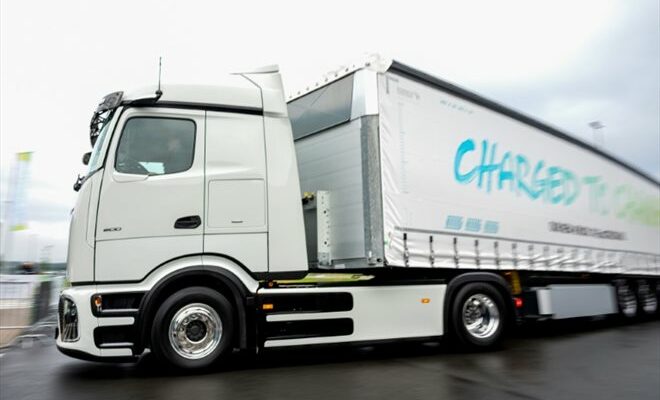The European Parliament and EU member states have agreed to reduce carbon emissions from heavy goods vehicles and generalize “zero-emission” buses (AFP/Archives/Daniel Bockwoldt)
The European Parliament and EU member states agreed on Thursday to reduce carbon emissions from heavy goods vehicles and generalize “zero-emission” buses in order to fight climate change.
Emissions from heavy vehicles sold from 2030 must be reduced by at least 45% compared to 2019, then lowered by 65% in 2035 and 90% in 2040, according to the text approved by the co-legislators.
The new regulations set a specific objective for urban buses which must be 100% zero emissions from 2035, with an intermediate objective setting the reduction to be achieved at 90% in 2030 for this category of vehicles.
For heavy goods vehicles, which run on diesel or gasoline, the shift towards electric or hydrogen (fuel cells or modified combustion engines) thus appears inevitable.
The German Daimler and the Swedish Volvo have already announced that they will mass produce hydrogen fuel cells for trucks from 2025. The world number one Mercedes-Benz Trucks recently presented its first long-distance electric truck model.
The American groups Tesla and Nikola or the Chinese BYD and Windrose are also in ambush, boosted at home by massive subsidy plans from Washington and Beijing.
The issue is crucial for European climate objectives: trucks, buses and coaches generate more than 6% of EU greenhouse gas emissions, a quarter of road transport emissions.
But the new regulations imply a real industrial revolution.
To meet the new CO2 reductions, the Association of European Automobile Manufacturers (ACEA) believes that the commitment of the entire transport ecosystem will be necessary, as will that of public authorities.
Its director general Sigrid de Vries called on Thursday for “electric charging and hydrogen filling infrastructure, comprehensive carbon pricing systems and significant support measures for transport operators to invest quickly”.
Without this, the timetable for the new constraints imposed on heavy goods vehicles will be “extremely difficult” to respect, she estimated.
To achieve the objectives set for 2030, more than 400,000 battery and hydrogen electric vehicles will need to be put into circulation.
Europe will then need at least 50,000 electric charging stations and at least 700 hydrogen charging stations, according to ACEA.
The European Union, which is aiming for carbon neutrality by 2050, had already approved the end of sales of new passenger cars with thermal engines in 2035.
© 2024 AFP
Did you like this article ? Share it with your friends using the buttons below.




